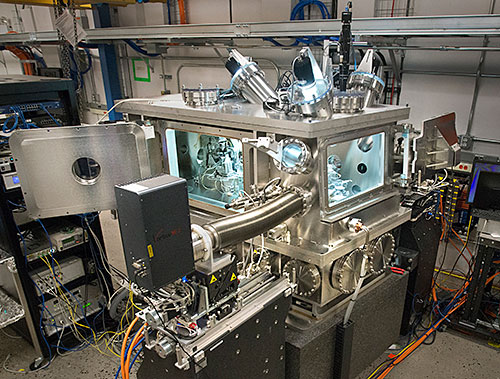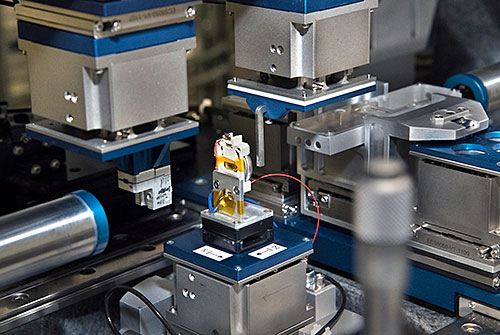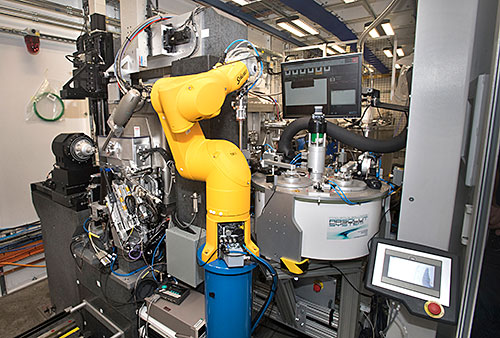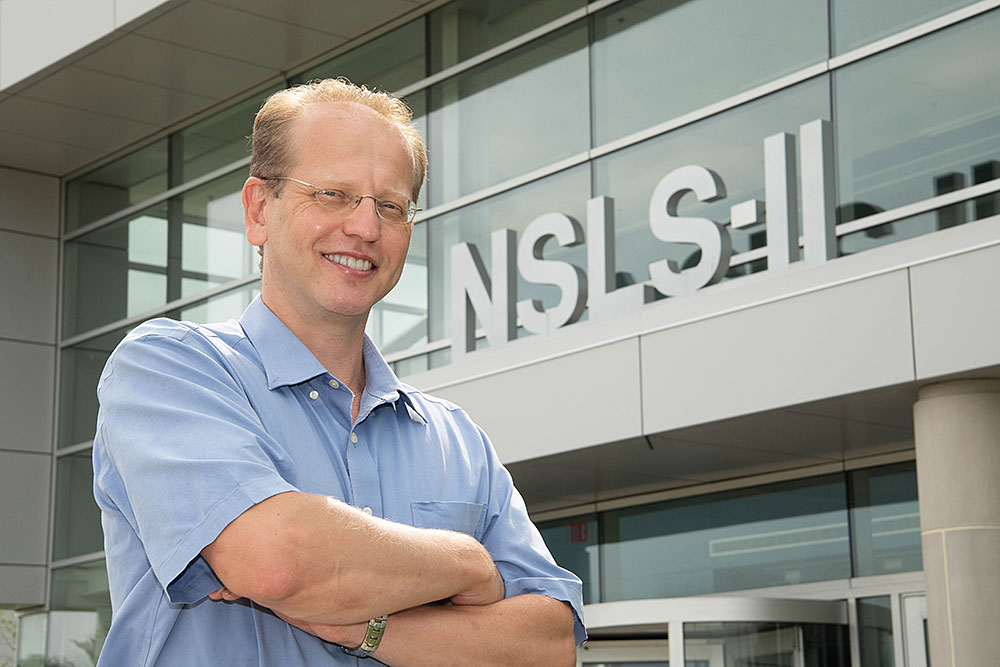Brookhaven Lab's Evgeny Nazaretski Named a Battelle 'Inventor of the Year'
The award recognizes Nazaretski's achievements in synchrotron light source instrumentation developments
September 10, 2020
UPTON, NY—Physicist Evgeny Nazaretski of the National Synchrotron Light Source II (NSLS-II)—a U.S. Department of Energy (DOE) Office of Science User Facility at DOE’s Brookhaven National Laboratory—has been selected as an “Inventor of the Year” by the global science and technology organization Battelle. Battelle manages Brookhaven Lab on behalf of the DOE through Brookhaven Science Associates, a partnership with Stony Brook University. The annual inventor awards recognize individuals who have made significant scientific or engineering contributions with important societal or financial impacts.
The awards committee recognized Nazaretski for his development of instrumentation for synchrotron light sources at NSLS-II, one of five DOE light sources in the U.S. By channeling the intensity of x-rays, synchrotron light sources can reveal the atomic structures of countless materials. To do this, light sources require very specialized equipment or instrumentation that can’t simply be bought off the shelf. For the last 10 years, Nazaretski has been leading the research and development (R&D) effort for such specialized equipment in the area of x-ray microscopy instrumentation at NSLS-II. These developments have had far reaching impacts on scientific research at NSLS-II by enabling new records such as the smallest x-ray spot in the world and the fastest x-ray tomography system used to visualize evolving nanostructures in real time.
“I very much enjoy working in the field of complex instrumentation development. You are facing a new challenge every time you build something new,” he said. “It is always very dynamic—never the same.
“Receiving such a prestigious award for my developments is a great honor. Throughout all my R&D projects, I was surrounded by wonderful colleagues and team members that supported every effort and made my work at the Lab very special.”
 enlarge
enlarge
The Hard X-ray Nanoprobe (HXN) beamline at the National Synchrotron Light Source II (NSLS-II) allows researchers to image a wide range of materials such as batteries and solar cells at the nanoscale. Nazaretski led the R&D team during the construction of this impressive microscope.
Nazaretski began his NSLS-II journey in 2009, when he joined the facility to lead R&D for construction of the x-ray microscope at the Hard X-ray Nanoprobe (HXN) beamline. It would later achieve the smallest x-ray spot in the world. He was also deeply involved in the collaborative effort at NSLS-II for the design, development, prototyping, and final construction of the HXN x-ray microscope, which is capable of imaging materials down to 10 nanometers—about one ten-thousandth of the diameter of a human hair.
“The first time I heard about the HXN project was back in 2009 at the American Physical Society (APS) March Meeting,” he said. “It sounded very ambitious and fascinating.” Later that year, he was invited to Brookhaven Lab to give a talk about his work at Los Alamos National Laboratory.
“Being here and hearing about the NSLS-II project and HXN was very exciting. Ultimately, I decided to leave Los Alamos and come to Brookhaven,” he said. “In order to realize the ambitious nano-focusing goal, we needed to address many technological challenges, such as environmental instabilities, motion and sensing on the nanometer scale, complex control of multiple constituents of an instrument, and effective characterization methods.”
HXN produces remarkably high-resolution images that can provide scientists with a comprehensive view of different materials properties in two and three dimensions. Researchers from all around the world now come to HXN to use the beamline for studies on next-generation battery materials, semiconductors, microelectronics, and on biological materials.
“Building the HXN x-ray microscope required significant ‘out-of-the-box' thinking,” said Yong Chu, manager of the Imaging and Microscopy Program at NSLS-II and lead beamline scientist of HXN. “We had to start from scratch, exploring the different instrument approaches used by the scanning probe microscopy community, in which Nazaretski spent his early professional career. For this reason, the HXN x-ray microscope looks very different from all x-ray microscopes built prior.”
The trick behind HXN’s high spatial-resolution imaging is a set of highly precise motors that can move in tiny steps while minimizing vibrations, instabilities, or drifts, and offering a wide variety of motions for controlling a set of specially designed multilayer Laue lenses (MLLs) and the sample material being studied. MLLs are special x-ray optics that are made of about 8,000 thin layers of different materials and this layered structure focuses the x-rays to 10 nm.
While the HXN beamline routinely runs with two independent MLLs to create its extremely small beam spot, it would be quite a challenge to equip other beamlines with a similar setup. So Nazaretski and his colleagues sought to address the challenge of more easily positioning individual MLLs so they can be adapted for use with other beamlines at NSLS-II and around the world.
They found a solution by bonding together two MLLs to create a single optic, instead of two optics that must be positioned separately. This new development will open the pathway to using MLLs at other beamlines for high-resolution x-ray imaging and could foster a new wave of exciting scientific results.
HXN is not the only beamline at NSLS-II that has benefited from Nazaretski’s knowledge and ingenuity. He was also involved in designing and building the heart of the Full Field X-ray Imaging (FXI) beamline. FXI is equipped with a fully in-house built transmission x-ray microscope (TXM) that researchers from many scientific fields use to see the structural and chemical makeup of their samples—everything from biological cells to energy storage materials.
 enlarge
enlarge
This close-up image shows the sample holder for the fully in-house built transmission x-ray microscope at the Full Field X-ray Imaging (FXI) beamline. This NSLS-II beamline is capable of imaging samples 10 times faster than any other beamline of its kind.
TXMs are used widely within the light source research community and their capability to capture x-ray tomography images is highly valued. One drawback with most TXMs in the world is they need about 10 minutes or longer to capture a full 3-D tomographic image, which means that capturing changes and dynamics within samples is limited to that time scale. The TXM system Nazaretski and the team developed for FXI leverages the high-flux x-rays NSLS-II produces to produce image samples 10 times faster than previously possible. FXI can take a tomographic image in just one minute, while still producing the image with exceptional 3-D resolution—below 50 nanometers, or 50 billionths of a meter. This new speed allows scientists to watch changes in their samples at a significantly faster rate.
 enlarge
enlarge
Nazaretski supported the instrumentation development at the Frontier Microfocusing Macromolecular Crystallography (FMX) beamline at NSLS-II. This beamline offers a highly focused beam to collect data from extremely small protein crystals.
Beyond his work in the imaging and microscopy program, Nazaretski has also supported instrumentation development in other areas at NSLS-II. As part of a team of scientists and engineers, he developed an instrument that enables ultra-precise and high-speed characterization of protein crystals. Protein crystallography is an essential research technique for uncovering the 3-D structures of proteins and other complex biological molecules to accelerate drug design, improve medical treatments, and unravel other environmental and biochemical processes governing our everyday lives.
“The challenge with protein crystallography is that the measurement of a full dataset takes quite some time,” he said. “Using our new ultra-high speed and high-precision FastForward MX goniometer, we are able to collect serial crystallography data so fast that complete datasets only take a few minutes.”
Nazaretski attributes his knowledge and innovations to the great opportunities he’s encountered during his career across two continents and many scientific institutions. He earned his PhD from the University of Bayreuth, Germany, where he studied quantum solids and fluids at ultra-low temperatures. From Germany, he moved to the U.S. to take a postdoc position at Cornell University.
“While at Cornell, I was very fortunate to meet and work with amazing colleagues and be a part of fascinating projects,” he explained. “I had joined the group of [American Physical Society Fellow and the Physics Department chair] Prof. Jeevak Parpia, and had the opportunity to work with Robert Otto Pohl, the National Academy of Science Member, and David Lee, who won the Nobel prize in 1996.”
Following his time at Cornell, Nazaretski became a Director’s Fellow at DOE’s Los Alamos National Laboratory, where he worked on the development and applications of scanning probe microscopy for condensed matter physics and materials science. After six years at Los Alamos—first as a fellow and then as a staff scientist—he joined the team at NSLS-II where he currently is a tenured physicist.
“We are very fortunate to have Evgeny at NSLS-II,” said facility Director John Hill. “He has used his skill and expertise in innovative ways to deliver truly world class performance for our users at a number of beamlines. This award is well deserved recognition of his contribution and we are all delighted for him.”
To date, Nazaretski has co-authored over 100 journal articles, delivered numerous invited and contributed talks at national and international conferences and symposia, and he is a recipient of multiple awards including the Microscopy Today Innovation Award, the Los Alamos Achievement Award, Long Island Innovator of the Year Award, Brookhaven Engineering Award, and the R&D 100 Award.
Brookhaven National Laboratory is supported by the U.S. Department of Energy’s Office of Science. The Office of Science is the single largest supporter of basic research in the physical sciences in the United States and is working to address some of the most pressing challenges of our time. For more information, visit https://energy.gov/science.
Follow @BrookhavenLab on Twitter or find us on Facebook.
2020-17394 | INT/EXT | Newsroom










